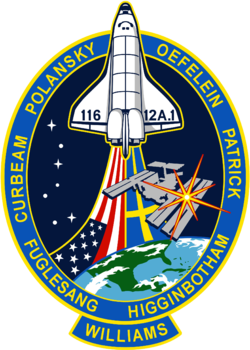Robert Lee Curbeam
| Robert Lee Curbeam | |
|---|---|
 Robert Lee Curbeam | |
| Astronaut NASA | |
| Státní příslušnost | |
| Datum narození | 5. března 1962 (60 let) |
| Místo narození | Baltimore, Maryland |
| Hodnost | kapitán |
| Čas ve vesmíru | 37 dní, 14 hodin a 33 minut |
| Kosmonaut od | 1994 |
| Mise | STS-85, STS-98, STS-116 |
| Znaky misí | |
| Některá data mohou pocházet z datové položky. | |
Robert Lee Curbeam (* 5. března 1962 v Baltimore, stát Maryland, USA) je americký důstojník námořnictva a kosmonaut. Ve vesmíru byl třikrát.
Život
Studium a zaměstnání
Robert Lee Curbeam absolvoval střední školu Woodlawn High School v Portsmouthu (1980) a pokračoval ve studiu na vojenské námořní akademii (US Naval Academy. Po ukončení studia v roce 1984 pokračoval na téže škole postgraduálním studiem a nakonec absolvoval i pilotní školu. Studia ukončil v roce 1991.
V námořnictvu byl v letech 1991 až 1994. V letech 1994 až 1995 prodělal výcvik kosmonautů, do jednotky NASA v Houstonu byl zařazen v roce 1996.
Oženil se s Julií, rozenou Leinovou.
Lety do vesmíru
Na oběžnou dráhu se v raketoplánech dostal třikrát ve funkci letového specialisty a strávil ve vesmíru 37 dní, 14 hodin a 33 minut. Absolvoval sedm výstupů do volného vesmíru (EVA) v úhrnné délce 45 hodin a 34 minut.
Byl 361. člověkem ve vesmíru.
- STS-85 Discovery, (7. srpen 1997 – 19. srpen 1997)
- STS-98 Atlantis (7. únor 2001 – 16. únor 2001)
- STS-116 Discovery (10. prosinec 2006 – 22. prosinec 2006)
Odkazy
Externí odkazy
 Obrázky, zvuky či videa k tématu Robert Lee Curbeam na Wikimedia Commons
Obrázky, zvuky či videa k tématu Robert Lee Curbeam na Wikimedia Commons - Na webu Space
- Na webu MEK-Kosmo
Média použitá na této stránce
The STS-116 patch design signifies the continuing assembly of the International Space Station (ISS). The primary mission objective is to deliver and install the P5 truss element. The P5 installation will be conducted during the first of three planned spacewalks, and will involve use of both the shuttle and station robotic arms. The remainder of the mission will include a major reconfiguration and activation of the ISS electrical and thermal control systems, as well as delivery of Zvezda Service Module debris panels, which will increase ISS protection from potential impacts of micro-meteorites and orbital debris. In addition, a single expedition crewmember will launch on STS-116 to remain onboard the station, replacing an expedition crewmember that will fly home with the shuttle crew. The crew patch depicts the space shuttle rising above the Earth and ISS. The United States and Swedish flags trail the orbiter, depicting the international composition of the STS-116 crew. The seven stars of the constellation Ursa Major are used to provide direction to the North Star, which is superimposed over the installation location of the P5 truss on ISS. The NASA insignia design for shuttle space flights is reserved for use by the astronauts and other official use as the NASA Administrator may authorize. Public availability has been approved only in the form of illustrations by the various news media. When and if there is any change in this policy, which is not anticipated, such will be publicly announced.
The mission patch for STS-85 is designed to reflect the broad range of science and engineering payloads on the flight. The primary objectives of the mission were to measure chemical constituents in Earth's atmosphere with a free-flying satellite and to flight-test a new Japanese robotic arm designed for use on the International Space Station (ISS). STS-85 was the second flight of the satellite known as Cryogenic Infrared Spectrometers and Telescopes for the Atmosphere-Shuttle Pallet Satellite-2 CRISTA-SPAS-02. CRISTA, depicted on the right side of the patch pointing its trio of infrared telescopes at Earth's atmosphere, stands for Cryogenic Infrared Spectrometers and Telescopes for the Atmosphere. The high inclination orbit is shown as a yellow band over Earth's northern latitudes. In the Space Shuttle Discovery's open payload bay an enlarged version of the Japanese National Space Development Agency's (NASDA) Manipulator Flight Demonstration (MFD) robotic arm is shown. Also shown in the payload bay are two sets of multi-science experiments: the International Extreme Ultraviolet Hitchhiker (IEH-02) nearest the tail and the Technology Applications and Science (TAS-01) payload. Jupiter and three stars are shown to represent sources of ultraviolet energy in the universe. Comet Hale-Bopp, which was visible from Earth during the mission, is depicted at upper right. The left side of the patch symbolizes daytime operations over the Northern Hemisphere of Earth and the solar science objectives of several of the payloads.
This is the insignia for STS-98, which marks a major milestone in assembly of the International Space Station (ISS).
- Atlantis' crew will deliver the United States Laboratory, Destiny, to the ISS. Destiny will be the centerpiece of the ISS, a weightless laboratory where expedition crews will perform unprecedented research in the life sciences, materials sciences, Earth sciences, and microgravity sciences. The laboratory is also the nerve center of the Station, performing guidance, control, power distribution, and life support functions. With Destiny's arrival, the Station will begin to fulfill its promise of returning the benefits of space research to Earth's citizens.
- The crew patch depicts the Space Shuttle with Destiny held high above the payload bay just before its attachment to the ISS. Red and white stripes, with a deep blue field of white stars, border the Shuttle and Destiny to symbolize the continuing contribution of the United States to the ISS. The constellation Hercules, seen just below Destiny, captures the Shuttle and Station's team efforts in bringing the promise of orbital scientific research to life. The reflection of Earth in Destiny's window emphasizes the connection between space exploration and life on Earth.




